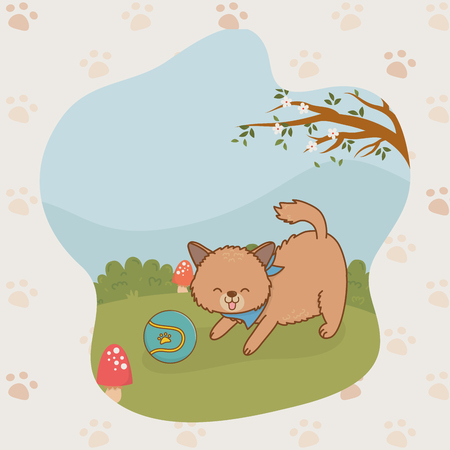Understanding Your Exotic Pet’s Natural Habitat
Before setting up a naturalistic habitat for your exotic pet, its essential to understand its native environment. Researching the climate, terrain, and typical behaviors of your pet in the wild will help you create a space that feels like home.
Researching Your Pet’s Native Environment
Each exotic pet comes from a unique ecosystem with specific environmental conditions. To mimic these conditions, consider the following factors:
| Environmental Factor | Questions to Consider |
|---|---|
| Climate | Does your pet originate from a hot and humid rainforest or a dry desert? What are the average temperatures and humidity levels? |
| Terrain | Is your pet used to climbing trees, burrowing underground, or living in rocky areas? |
| Typical Behavior | Is your pet nocturnal or active during the day? Does it prefer solitude or social interaction? |
Mimicking Natural Conditions
Once you understand your pet’s natural habitat, you can begin recreating those conditions in its enclosure. Here are some key elements to consider:
Temperature and Humidity Control
If your pet thrives in warm environments, invest in heat lamps or heating pads. For humidity-loving species, misting systems or water features may be necessary.
Terrain and Substrate Selection
Select a substrate that matches your pet’s natural ground covering. Sand is great for desert animals, while bark or moss suits rainforest dwellers.
Shelter and Hiding Spots
Your pet needs places to hide and feel secure. Use rocks, logs, plants, or artificial caves to create safe hiding spots.
Space for Natural Behaviors
If your pet enjoys climbing, add branches and vines. If it burrows, provide deep substrate layers for digging.
The Importance of Observation
After setting up the habitat, observe how your pet interacts with it. If it seems stressed or avoids certain areas, adjustments may be needed. Small changes can make a big difference in ensuring your pet feels comfortable and behaves naturally.
2. Choosing the Right Enclosure
Selecting the perfect enclosure for your exotic pet is crucial to creating a naturalistic habitat. The right setup ensures your pet has enough space to move, explore, and feel comfortable while also maintaining proper ventilation and accessibility.
Consider the Size and Space
Your pet’s enclosure should be appropriately sized based on its species, size, and activity level. A cramped space can lead to stress and health issues, while too large of an enclosure might make it difficult to maintain the correct environment.
| Pet Type | Recommended Enclosure Size | Special Considerations |
|---|---|---|
| Small Reptiles (e.g., Leopard Geckos) | 20-gallon tank or larger | Avoid excessive height; prioritize floor space |
| Large Snakes (e.g., Ball Pythons) | At least 4×2 feet for adults | Secure locking mechanism to prevent escapes |
| Tropical Birds (e.g., Parrots) | Aviary-style cage with horizontal bars | Sufficient room for flying and climbing |
| Aquatic Turtles | Aquarium of at least 40 gallons | Basking area with UVB lighting is essential |
Ensure Proper Ventilation
A well-ventilated enclosure helps regulate temperature and humidity while preventing mold or bacterial growth. Mesh panels, cross-ventilation openings, and screen lids are excellent ways to ensure fresh airflow without compromising security.
Select Accessible Features
Your pet’s enclosure should have easy access points for feeding, cleaning, and handling. Sliding doors or front-opening designs are ideal for reptiles, while top-access enclosures work better for certain small mammals and amphibians.
Avoid These Common Mistakes:
- Crowding the Space: Too many decorations or hides can limit movement.
- Poor Ventilation: Fully enclosed setups without air circulation can cause respiratory problems.
- Lack of Security: Weak locks or loose-fitting lids may lead to escapes.
- Inefficient Layout: Make sure there is a balance between open space and hiding spots.
The right enclosure is the foundation of your exotic pets well-being. By ensuring ample space, proper airflow, and easy accessibility, you create a comfortable and naturalistic home where your pet can thrive.

3. Creating a Realistic Habitat Setup
Designing a naturalistic habitat for your exotic pet means replicating the key elements of their native environment. By incorporating natural materials and structures, you help create a space that promotes their well-being and encourages natural behaviors.
Choosing the Right Substrate
The substrate is the foundation of your pet’s habitat. The right choice depends on your pet’s species and natural environment:
| Pet Type | Recommended Substrate |
|---|---|
| Desert Reptiles (e.g., Bearded Dragons) | Sand or a sand-soil mix |
| Tropical Amphibians (e.g., Dart Frogs) | Coconut fiber or sphagnum moss |
| Forest-Dwelling Lizards (e.g., Crested Geckos) | Bark chips or organic soil |
| Aquatic Turtles | Smooth river rocks or fine gravel |
Add Live or Artificial Plants
Plants not only enhance the aesthetics of the enclosure but also provide hiding spots and humidity control. Live plants are ideal for species that require high humidity, while artificial plants can be used for easy maintenance.
Best Plant Choices Based on Habitat Type:
- Tropical Enclosures: Pothos, bromeliads, ferns
- Desert Setups: Succulents, cacti (only non-toxic varieties)
- Aquatic Tanks: Java fern, anubias, hornwort
Create Hiding Spots and Climbing Structures
Your exotic pet needs places to feel secure and explore. Providing adequate hiding spots helps reduce stress, while climbing structures encourage physical activity.
Ideal Hides and Climbing Features:
- Caves and Logs: Great for burrowing reptiles and nocturnal animals.
- Cork Bark and Hollow Logs: Perfect for arboreal reptiles and amphibians.
- Ladders, Vines, and Branches: Essential for climbing species like chameleons.
- Tunnels and Burrows: Beneficial for small mammals like hedgehogs.
Add a Water Feature
A water source is crucial for hydration and maintaining proper humidity levels. The type of water feature depends on your pets needs:
| Pet Type | Recommended Water Feature |
|---|---|
| Turtles & Amphibians | Aquatic pool or shallow pond with clean, filtered water. |
| Tropical Reptiles (e.g., Chameleons) | Misting system or drip water source to simulate rain. |
| Mammals (e.g., Hedgehogs) | A shallow dish with fresh water changed daily. |
| Semi-Arboreal Species (e.g., Geckos) | A small water bowl placed near climbing areas. |
A well-designed habitat setup improves your exotic pet’s quality of life by mimicking their natural surroundings. Paying attention to substrate, plants, hiding spots, climbing features, and water sources ensures they have everything they need to thrive in captivity.
4. Managing Temperature, Humidity, and Lighting
Creating a naturalistic habitat for your exotic pet means maintaining the right climate conditions. Temperature, humidity, and lighting play a crucial role in keeping your pet healthy and comfortable. Using tools like heat lamps, UVB lighting, misting systems, and humidity monitors can help you replicate their natural environment.
Temperature Control
Many exotic pets require a specific temperature range to thrive. Reptiles, amphibians, and tropical species need both warm and cool areas within their enclosure to regulate body temperature properly.
Heat Sources
- Heat Lamps: Provide a basking spot for reptiles that need external heat sources.
- Ceramic Heaters: Offer consistent warmth without emitting light, ideal for nighttime heating.
- Under-tank Heaters: Great for ground-dwelling animals that absorb heat from below.
Temperature Guidelines
| Pet Type | Basking Temperature | Cool Side Temperature |
|---|---|---|
| Bearded Dragon | 95-110°F (35-43°C) | 75-85°F (24-29°C) |
| Ball Python | 88-92°F (31-33°C) | 75-80°F (24-27°C) |
| Crested Gecko | N/A (Prefers ambient temps) | 72-78°F (22-26°C) |
Humidity Management
Maintaining proper humidity levels is essential for hydration, shedding, and respiratory health. A misting system or manual spraying can help regulate moisture levels in the enclosure.
Ways to Maintain Humidity
- Misting Systems: Automated systems keep humidity consistent throughout the day.
- Humidity Monitors: Digital hygrometers help track moisture levels accurately.
- Substrate Choice: Coconut fiber or sphagnum moss helps retain moisture.
- Water Bowls: Placing large water dishes in the enclosure increases ambient humidity.
Recommended Humidity Levels by Species
| Pet Type | Ideal Humidity Range |
|---|---|
| Crested Gecko | 60-80% |
| Ball Python | 50-60% |
| Dart Frog | 70-100% |
| Tortoise (Desert Species) | 30-40% |
Lighting Requirements
Adequate lighting is crucial for exotic pets, especially those that require UVB exposure for calcium absorption and overall health.
Types of Lighting
- UVB Bulbs: Essential for reptiles like turtles and lizards to prevent metabolic bone disease.
- Basking Lights: Provide necessary warmth and encourage natural behaviors.
- Naturally Timed Lighting: Use timers to simulate day-night cycles for better sleep patterns.
Selecting the Right UVB Strength
| Pet Type | Recommended UVB Strength | Basking Distance from Bulb |
|---|---|---|
| Bearded Dragon | 10.0 UVB (High Output) | 12-18 inches (30-45 cm) |
| Crested Gecko | No UVB Required (Optional 5.0 UVB) | N/A or 12 inches (30 cm) if used |
| Tortoise (Tropical Species) | 10.0 UVB | 12 inches (30 cm) |
The right combination of temperature, humidity, and lighting ensures your exotic pet stays healthy and active. Monitoring these factors regularly will help create a stable and naturalistic habitat that mimics their wild environment as closely as possible.
5. Maintaining and Monitoring the Habitat
Once your exotic pet’s naturalistic habitat is set up, regular maintenance and monitoring are essential to ensure a healthy and comfortable environment. Keeping the habitat clean, checking environmental conditions, and making necessary adjustments will help keep your pet happy and thriving.
Regular Cleaning and Inspection
A clean habitat prevents bacteria buildup, reduces odors, and keeps your pet safe from potential health issues. Develop a cleaning schedule based on your pet’s needs.
| Task | Frequency |
|---|---|
| Remove uneaten food and waste | Daily |
| Check water supply and replace if dirty | Daily |
| Wipe down surfaces and spot-clean substrate | Every few days |
| Deep clean enclosure (replace substrate, disinfect decor) | Weekly or bi-weekly |
| Inspect for mold, pests, or damage to decorations | Monthly |
Monitoring Environmental Conditions
Your exotic pet depends on stable environmental conditions to stay healthy. Regularly check temperature, humidity, lighting, and ventilation using reliable tools.
Temperature:
Use digital thermometers to monitor warm and cool zones.
Humidity:
Hygrometers help track moisture levels to prevent dehydration or respiratory issues.
Lighting:
Ensure proper day-night cycles with timers for UVB or heat lamps.
Ventilation:
Check airflow to prevent stagnant air and mold buildup.
Troubleshooting and Adjustments
If you notice changes in your pet’s behavior or health, assess the habitat conditions and make necessary adjustments. Here are some common issues and solutions:
| Issue | Possible Cause | Solution |
|---|---|---|
| Your pet is hiding more than usual | Lack of proper temperature or feeling stressed | Check temperature settings and provide additional hiding spots |
| Mold or mildew in the habitat | Poor ventilation or excessive humidity | Add ventilation holes, reduce misting frequency, or use a drier substrate |
| Your pet refuses food | Tank temperature too low or stress-related issues | Ensure optimal temperature and minimize disturbances around the enclosure |
A well-maintained habitat ensures that your exotic pet remains healthy and comfortable. By staying consistent with cleaning routines, monitoring environmental factors, and making timely adjustments, you create an ideal home where your pet can thrive.


